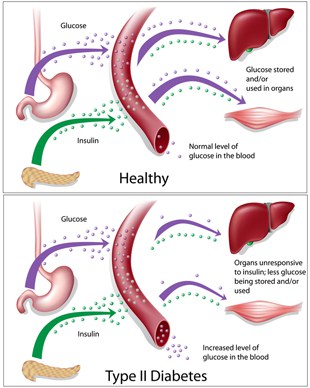Glucose Tolerance Test Fact Sheet
As people age, their bodies may have a harder time making insulin. The cells that produce insulin can be overworked and worn out when people eat too much, or even as a natural part of the aging process. The body uses insulin to control blood sugar levels after eating, so every time someone has sugar, from natural or artificial sources, their pancreas must secrete insulin. In some people, this ability becomes impaired and they develop type 2 diabetes. For every year that someone has type 2 diabetes, it is as if they age an extra year. Age-related conditions, such as arthritis, high blood pressure, heart disease, loss of vision, and even gray hair, may happen at a younger age in people with type 2 diabetes.
A sign of diabetes or pre-diabetes is a noticeable spike in blood sugar after large meals. One test that checks for this is the glucose tolerance test. By checking blood sugar levels within a couple of hours of eating something sugary, doctors can discover if a patient has impaired glucose tolerance (IGT). If caught early on, lifestyle changes can help to manage the situation before it progresses to diabetes, which is why the glucose tolerance test is an important screening test and tool for diabetes prevention.
Overview of the Test
With a simple glucose tolerance test, people learn whether their body is able to maintain ideal blood sugar levels. The test makes it very clear how impaired someone’s glucose tolerance has become. The test is not invasive and is about as unpleasant as swallowing a spoon full of sugar.
For the test to work, someone needs to ingest a large amount of sugar, and their body will then release insulin to regulate the levels of sugar in the blood. Insulin forces cells to take in sugar from the blood, so if there is not enough insulin, it means that less sugar is forced into cells, leaving higher amounts in the blood.
Taking steps to correct the situation and then testing again to be sure the body has responded contributes to better health and slower aging. Not knowing about and correcting impaired glucose resistance can result in a loss of function (diabetes).
How it is done
For a glucose tolerance test, doctors begin by taking a blood sample. Patients are then given a large dose of sugar, either by mouth or through an injection. Taking sugar by mouth mixed with water is most common. Another blood draw occurs every 30 minutes to an hour following the injection and over the course of three hours. The insulin levels in the blood samples are then measured and compared.
A person given the standard 75 grams of sugar during the test will have an insulin level of 60 to 100 milligrams per deciliter before the sugar intake. At one hour after ingestion, an insulin level below 200 milligrams per deciliter is normal. Insulin levels should drop to 140 milligrams per deciliter after two hours.
In the unusual instance where a sugar injection is used instead of oral blood sugar, a health care professional injects the sugar into a vein for three minutes. The insulin levels are assessed in the blood before the sugar injection and at one and three minutes following the injection.
When and How Often
Pregnant women need oral glucose tolerance tests to check if they have gestational diabetes. This is performed when women are 24 to 28 weeks pregnant. A doctor can also order the test anytime gestational diabetes is suspected.
People who are at risk for type 2 diabetes should be checked as well. Being overweight puts one at risk. Men with a waist circumference of 94 centimeters, or 37 inches, or greater at the narrowest part of the waist have an increased risk. A waist that is 102 centimeters, or 40 inches, or wider indicates a significantly risk. Women whose waists are 80 centimeters, or 32 inches, or more have an increased risk. A waist that is 88 centimeters, or 35 inches, or wider suggests a significant risk.
Who does it?
GPs
Cost
A glucose tolerance test may be covered by insurance. An out-of-pocket fee for a glucose tolerance test conducted at a hospital costs around $25 to $100.
References
- Harvard Medical School
- Defeat Diabetes Foundation, Inc.
- Medline Plus
- Healthcare Blue Book
- Fast Living Slow Ageing; Kate Marie and Christopher Thomas; 2009
Last reviewed 26/Feb/2014






